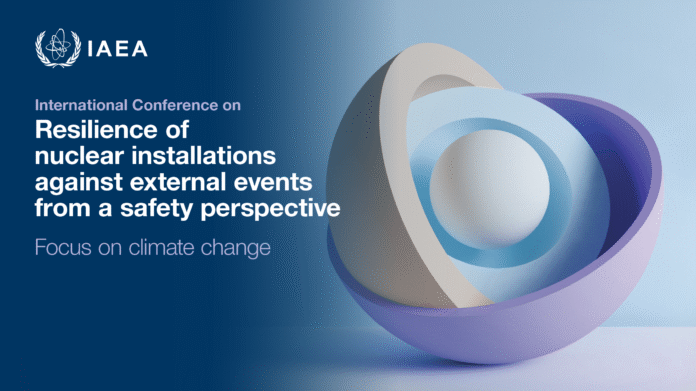Introduction to the International Conference
The upcoming International Conference hosted by the International Atomic Energy Agency (IAEA) will take place in Vienna from October 20-24, 2025. This pivotal event is designed to gather stakeholders from various sectors involved in nuclear energy, including regulatory bodies, industry experts, and international organizations, to discuss the pressing need for enhancing safety standards at nuclear facilities in the context of external hazards. Amid growing concerns about natural disasters, the conference aims to provide a comprehensive platform for sharing knowledge and best practices that can bolster the resilience of nuclear installations.
One of the primary objectives of the conference is to address the increasing frequency and intensity of climate-related hazards, such as floods, hurricanes, and earthquakes, which pose significant risks to the integrity and safety of nuclear facilities. Ensuring robust safety measures against these challenges is critical to prevent any potential accidents and to protect public health and the environment. Discussions will focus on the integration of advanced technologies and innovative approaches that can mitigate the impact of external threats.
The IAEA is collaborating with the World Meteorological Organization (WMO) to enhance the scope of this conference further. By leveraging meteorological data and expertise, the conference seeks to improve predictive capabilities for natural disasters, thereby enabling better preparedness and response strategies within the nuclear industry. This partnership underscores the importance of interdisciplinary cooperation in strengthening the safety frameworks surrounding nuclear operations.
In summary, this conference serves as an essential dialogue platform aimed at refining safety protocols and fostering a culture of resilience within the nuclear sector, ultimately contributing to a safer future for energy production in the face of increasingly unpredictable environmental challenges.
The Importance of Resilience in Nuclear Facilities
The resilience of nuclear facilities is a crucial aspect that must be prioritized to ensure their safety amidst evolving threats. As climate change continues to impact global weather patterns, the frequency and intensity of extreme weather events have increased, posing a significant risk to nuclear installations. Consequently, adapting safety measures to account for these external hazards is essential for safeguarding both personnel and the environment. Nuclear facilities must be equipped with modernized safety protocols that reflect current and projected hazard analyses and developments in technology.
Recent insights from International Atomic Energy Agency (IAEA) officials emphasize the necessity of incorporating updated risk assessments into the operational frameworks of nuclear facilities. By doing so, these facilities can effectively identify vulnerabilities and implement innovative solutions that cater not only to existing infrastructure but also to new installations currently under planning. This proactive approach is vital in establishing a robust defense against potential external hazards, ensuring that nuclear facilities can withstand unprecedented challenges posed by climate change.
Moreover, fostering resilience in nuclear facilities is not merely about compliance with regulatory standards; it requires a comprehensive understanding of the dynamic nature of risk factors. The commitment to ongoing research and development efforts will enable nuclear operators to enhance their readiness and responsiveness to unforeseen events. By engaging in continuous dialogue with experts and stakeholders, nuclear facilities can stay ahead of evolving threats, leading to a safer operational environment. As we recognize the changing landscape of risks, it becomes increasingly evident that resilience is no longer optional but rather an imperative dimension in the management and operation of nuclear facilities.
Expert Insights and Discussions at the Conference
The conference on enhancing the resilience of nuclear facilities attracted a diverse array of participants, including nuclear safety experts, disaster management professionals, and regulatory authorities. This gathering of experts underscores the collaborative effort required to address the multifaceted challenges posed by external hazards to nuclear facilities. Among the key features of the conference were plenary sessions and keynote lectures led by recognized leaders in nuclear safety. These sessions provided valuable insights into current trends and future directions in the field.
The agenda included breakout discussions focusing on critical topics such as hazard analysis, which is essential for understanding the potential risks that external events pose to nuclear safety. Experts emphasized the importance of using advanced modeling techniques to predict the impacts of various hazards on reactor designs. Another focal point of the conference was the safety assessment of advanced reactor designs, which are increasingly being deployed globally. The discussions highlighted the need for a rigorous evaluation of these designs to ensure they can withstand external threats effectively.
In addition to formal sessions, the conference also prioritized emergency management strategies. Given the unpredictable nature of external hazards, robust emergency preparedness protocols are vital for all nuclear facilities. Networking opportunities were abundant, encouraging professionals from various sectors to connect and share experiences. These interactions facilitated discussions on best practices and innovative solutions to some of the most pressing safety challenges in the nuclear industry.
Ultimately, the exchange of ideas and collaborative spirit evident during the conference exemplifies the commitment of professionals in the nuclear safety field to enhance resilience against external hazards. Such gatherings are not only instrumental in fostering understanding among stakeholders but also serve as a catalyst for developing actionable strategies that bolster safety and preparedness across the nuclear sector.
Future Directions and Collaborative Efforts
The outcomes of the recent international conference centered on enhancing the resilience of nuclear facilities against external hazards have prompted a collective call for action. Acknowledging the increasing complexity of threats, stakeholders in the nuclear industry have convened to develop strategic guidelines aimed at bolstering nuclear safety. These guidelines, as recommended by the International Atomic Energy Agency (IAEA), outline a cooperative framework designed to address emerging challenges and reinforce the safety protocols that govern nuclear operations.
One of the primary goals of these collaborative efforts is to establish a robust network of dialogue among international partners, including governments, regulatory authorities, and facility operators. This network is expected to foster the sharing of best practices and innovative strategies to mitigate the risks posed by external hazards, such as climate change-related events and geopolitical tensions. The IAEA has proposed the creation of dedicated working groups that will focus on specific external threats, enabling stakeholders to develop targeted responses tailored to regional vulnerabilities.
Further initiatives include the introduction of comprehensive training programs aimed at enhancing the preparedness of personnel working in nuclear facilities. By investing in workforce development, the industry can ensure that staff are equipped with the necessary skills to respond effectively to emergencies and to implement the latest safety measures. Additionally, the incorporation of advanced technologies, such as artificial intelligence and predictive analytics, is being explored to improve risk assessment and decision-making capabilities in the face of unpredictable threats.
In conclusion, the concerted efforts highlighted during the conference are pivotal in shaping future resilience strategies for nuclear facilities. The emphasis on collaboration amongst industry stakeholders and the call for actionable guidelines set the stage for a proactive approach to enhancing nuclear safety against external hazards. As the nuclear sector evolves, continued international cooperation will be essential to address the challenges that lie ahead.


